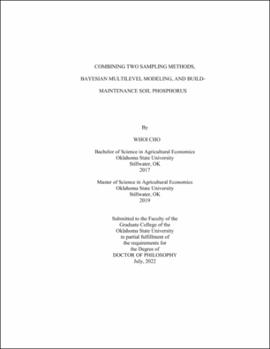| dc.contributor.advisor | Brorsen, B. Wade | |
| dc.contributor.author | Cho, Whoi | |
| dc.date.accessioned | 2023-04-05T16:20:48Z | |
| dc.date.available | 2023-04-05T16:20:48Z | |
| dc.date.issued | 2022-07 | |
| dc.identifier.uri | https://hdl.handle.net/11244/337268 | |
| dc.description.abstract | Chapter I: Sometimes two measurements are available to collect soil information: a low-cost noisy measurement and an accurate expensive one. For example, soil testing in a laboratory is expensive and accurate. On-the-go pH meters are available, but they are not as accurate. The question addressed here is what is the best way to combine these measures to guide precision applications? Bayesian kriging is proposed to estimate the joint spatial distribution considering spatial autocorrelation. This study also obtains the economic optimum ratio of expensive and accurate measurements by maximizing the expected net present value using Bayesian Decision Theory and a grid search procedure. | |
| dc.description.abstract | Chapter II: Absent check plots, near-zero treatment rates, or non-limiting treatment levels, it may be difficult to estimate accurately yield response functions. a Bayesian multilevel modeling approach is proposed to incorporate response parameters from published studies into crop yield response estimation procedures when non-limiting or limiting treatments are omitted in agronomic experiments. A proof-of-concept simulation supplements an empirical application. The simulation investigates the small sample properties of the proposed procedure. The empirical example uses field trial data for a maize planter experiment under different nitrogen (N) fertilizer rates. | |
| dc.description.abstract | Chapter III: There are two alternative approaches to managing soil phosphorus (P): sufficiency and build-maintenance. Sufficiency seeks to apply the minimum amount of P fertilizer that the crop needs in that year. At higher yield potential or intensive crop rotation, the crops consume more P than applied amounts of P fertilizer with a sufficiency approach. As the soil P level decreases due to higher crop removal, the expected crop yield decreases over time until an equilibrium is reached. The build-maintenance (BM) approach, however, seeks to build and (or) maintain the soil P level for crops so that P is not the limiting nutrient. However, the BM recommendation rate costs more in the short-term because it requires a higher rate than the sufficiency recommendation rate. The producer’s long-term returns will differ depending on each approach. This study compares the expected net present values of two alternative recommendation rates with various scenarios. | |
| dc.format | application/pdf | |
| dc.language | en_US | |
| dc.rights | Copyright is held by the author who has granted the Oklahoma State University Library the non-exclusive right to share this material in its institutional repository. Contact Digital Library Services at lib-dls@okstate.edu or 405-744-9161 for the permission policy on the use, reproduction or distribution of this material. | |
| dc.title | Combining two sampling methods, Bayesian multilevel modeling, and build-maintenance soil phosphorus | |
| dc.contributor.committeeMember | Lambert, Dayton M. | |
| dc.contributor.committeeMember | Riley, John M. | |
| dc.contributor.committeeMember | Arnall, D. Brian | |
| osu.filename | CHO_okstate_0664D_17747.pdf | |
| osu.accesstype | Open Access | |
| dc.type.genre | Dissertation | |
| dc.type.material | Text | |
| dc.subject.keywords | Bayesian kriging | |
| dc.subject.keywords | Bayesian multilevel modeling | |
| dc.subject.keywords | build-maintenance | |
| dc.subject.keywords | soil phosphorus | |
| thesis.degree.discipline | Agricultural Economics | |
| thesis.degree.grantor | Oklahoma State University | |
